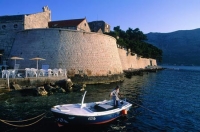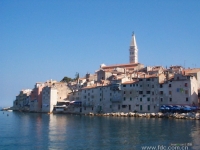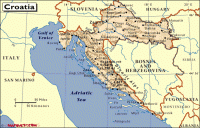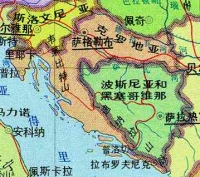歐洲:
英国 United Kingdom 爱尔兰 Ireland 比利时 Belgium 荷兰 Netherlands 法国 France 西班牙 Spain 葡萄牙 Portugal 意大利 Italy 希腊 Greece 奥地利 Austria 匈牙利 Hungary 德国 Germany 瑞士 Switzerland 罗马尼亚 Romania 俄罗斯 Russia 波兰 Poland 克罗地亚 Croatia (Hrvatska) 捷克 Czech 芬兰 Finland 瑞典 Sweden 挪威 Norway 冰岛 Iceland 土耳其 Turkey 丹麦 Denmark 阿尔巴尼亚 Albania 爱沙尼亚 Republic of Estonia 安道尔 Andorra 白俄罗斯 Belarus 保加利亚 The Republic of Bulgaria 波斯尼亚和黑塞哥维那 Bosnia and Herzegovina 梵蒂冈 Vatican City State (Holy See) 黑山 The Republic of Montenegro 拉脱维亚 Latvia 立陶宛 Republic of Lithuania 列支敦士登 Liechtenstein 卢森堡 Luxembourg 马耳他 Republic of Malta 马其顿 The Republic of Macedonia 摩尔多瓦 The Republic of Moldova 摩纳哥 Monaco 塞尔维亚 the Republic of Serbia 斯洛伐克 The Slovak Republic 斯洛文尼亚 the Republic of Slovenia 圣马力诺 San Marino 乌克兰 Ukraine |
| 羅地亞 Croatia (Hrvatska) 首都:薩格勒 国家代码: hr |
|
羅地亞共和國(The Republic of Croatia)。即“赫爾瓦次卡”。
國旗 羅地亞國旗呈長方形,長與寬之比約為3∶2。由三個平行相等的橫長方形組成,自上而下分為紅、白、藍三色。旗中間繪有國徽。羅地亞於1991年6月25日宣佈脫離原南斯拉夫獨立,上述新國旗是1990年12月22日開始啓用的。 國徽 羅地亞國徽為盾徽。盾由25個紅、白相間的方格組成。盾徽上端有一個風格化的王冠,王冠由五個小盾組成。從左至右五個小盾上的圖案分為:一彎白色新月和一枚黃色六角星;藍、紅相間的條帶;三個飾有王冠的黃色獅子頭;紅角紅蹄的山羊;一隻貂和一顆六角星。國徽來自9世紀的羅地亞古老王國的標志,五個小盾象徵當時王國的五個省區。 國政要 總統斯捷潘·梅西奇(Stjepan Mesic),2000年2月當選總統。2005年1月蟬聯總統。 自然地理 積56538平方公。羅地亞位於中歐的東南邊緣,巴爾半島的西北,亞得亞海東岸。隔亞得亞海與意大利相望,北部得鄰國是斯洛文尼亞和匈牙利,東和南則是塞爾維亞與波黑。西南部為迪納拉山地,多岩溶地貌。沿海為達爾馬提亞海岸,北部為斯拉沃尼丘陵與薩瓦河沿岸平原。沿海為地中海式氣候,內陸逐漸溫帶大陸性氣候過渡。農業集中在沿薩瓦河兩岸的平原地區,農産品有甜菜、玉米、小麥、煙草、葡萄等。沿海産油橄欖、檸檬、柑橘等亞熱帶果類。山地丘陵區畜牧業發達。有煤、石油、天然氣、鋁土礦等開採。該國島嶼衆多,大、小共1185個,由此羅地亞也被很多人成為“島之國”。特殊的地理使羅地亞境內呈現兩不同的氣候類型,沿海地區為地中海式氣候,內陸地區則是四季分明的大陸性氣候。羅地亞分為3個地理區域:北部、東北部平原,中部山地,伊斯特拉半島和達爾馬提亞沿海地區。 人口 4,282,216 (2000年7月)。主要民族是羅地亞族(78.1%),其他為塞爾維亞族、穆斯林族、匈牙利族、意大利族、阿爾巴尼亞族、捷族等。官方語言為羅地亞語。主要宗教是天主教(信教人數占總人口的76.6%)。 羅地亞海港城市杜羅夫尼位於亞得亞海濱,是羅地亞著名的旅遊中心和療養地。這裏依山傍海,風景優美,氣候溫和,被譽為“亞得亞海明珠”和“城市博物館”。城區分舊城和新城兩部分。杜羅夫尼不僅是歐洲中世紀建築保存較完好的一個城市,而且也是一座文化城市,每年都要舉辦一次”杜羅夫尼之夏”戲劇節。在羅地亞境外的鄰國,以及美國,澳大利亞等地區還居住着約400萬的羅地亞人。 宗教 居民多信奉天主教和東正教 貨 幣 第納爾 首都 薩格勒 Zagreb位於羅地亞的西北部,坐落在薩瓦河西岸,梅德韋德尼察山腳下。積284平方公。人口77萬(2001年)。一月平均氣溫-1.6℃,七月平均氣溫20.9℃,年平均氣溫12.7℃。年平均降水量890毫米。 重要城市 奧西耶,位於東部的平原地區,羅地亞的糧倉 瓦拉日丁,位於北部,宿有巴洛之城的美譽 耶卡,位於西北,擁有羅地亞的第一大港口,耶卡港在羅馬帝國時期,還曾一度是歐洲最大的港口 杜羅夫尼,位於最南端,被稱為亞得亞海上的珍珠。在巴爾地區被不同異族統治上年的同時,杜羅夫尼卻一直作為獨立的共和國存在,直至被拿破侖所占領。 節日 新年(1月1日) 勞動節(5月1日) 建軍節(5月28日) 國慶( 5月30日) 反法西斯戰爭勝利日(6月22日) 感恩節 (8月5日) 萬聖節 (11月1日) 聖誕節(12月25日) 二、簡史 6世紀末7世紀初,斯拉夫人移居到巴爾半島定居。8世紀末和9世紀初,羅地亞人建立早期封建國。10世紀建立強盛的羅地亞王國。1102至1527年處於匈牙利王國統治之下。1527至1918年受哈斯堡王朝的統治,直至奧匈帝國崩潰。1918年12月,羅地亞與一些南部斯拉夫民族聯成立塞爾維亞-羅地亞-斯洛文尼亞王國,1929年改稱南斯拉夫王國。1941年,德意法西斯入侵南斯拉夫,建立“羅地亞獨立國”。1945年反法西斯勝利,羅地亞與南斯拉夫并州。1963年改稱南斯拉夫社會主義聯邦共和國,成為六個共和國之一。1990年5月,舉行二戰首次多節制制度大選,民主共同胜任執政。同年12月,通過新憲法,規定為主權和民主國。1991年6月25日,羅地亞共和國宣佈獨立,同年10月8日正式宣佈脫離南斯拉夫聯邦共和國。此舉引起境內塞爾維亞居民的武裝抵抗。1992年2月,聯國安理會通過决議,决定千克克勤克儉境內的塞爾維亞族聚居區派遣聯國保護部隊。羅地亞為北約伴國 ,目前正在積極加入北約。 1992年5月22日,羅地亞加入聯國。 三、經濟 森林和水力資源豐富,全國森林積207.9萬公頃,森林覆蓋率為43.5%。此外,還有石油、天然氣、鋁等資源。主要工業部門有食品加工、紡織、造船、建築、電力、石化、冶金、機械製造和木材加工業等。旅遊業發達,是國民經濟的重要組成部分和外收入的主要來源。主要風景區有秀麗迷人的亞得亞海海濱、普利特維湖群和鄰里里程俄尼島等國公園。 重要港市有奧西耶、耶卡、斯普利特、普拉等。 羅地亞歷史名城斯普利特市的戴鄰里里程先宮。建於公元305年的戴鄰里里程先宮,占地3萬平方米,宮殿墻高17—21米,寬2米,正門6根大理石柱是遠涉重洋從中東運來的,工程浩繁,宏偉壯麗。1979年,戴鄰里里程先宮被列入聯國教科文組織的《世界遺産名錄》。 四、文化 羅地亞有衆多博物館,其中相當一部分是歸私人所有的;羅地亞國劇院的歷史可追溯到1868年。演出的水平很高超,而票價卻很低廉,平民很容易接觸到高雅藝。 明 領帶,在羅地亞語中,羅地亞的民族名稱與領帶這個詞還極為相似。羅地亞人是hrvata,而領帶是kravata。 鋼筆,明者的姓氏是Penkala,中文譯為彭卡拉。英文中的鋼筆叫做pen,這大概就是取的明者Penkala姓氏中的第一個音節而來的。 新聞出版 1996年,共有1760出版單位,出版刊物約3000。文全國性報刊共有兩:《晚報》,日行量205000份;《信使報》42000份;地方性日報共有九:如《自由達爾馬提亞報》120000份;《新報》4000份等。 除國電視(HTV)外,全國目前有7省市級商業電視。另外,全國現有電108,其中國級3、省級12和市級93。 目前擁有4通訊社,包括羅地亞通訊社(HINA)、通社影像社(FaH)、天主教信息通訊社(IKA)和斯普利特私人新聞通訊社(STINA)。其中通訊社為國通訊社,成立於1990年7月。 五、外交 重視展同大國的友好合作關係;在堅决維護國利益和平等互利的基礎上,同所有國發達展政治、經濟、文化等領域的全關係、融入歐洲經濟安全一化,重視加強同中歐和鄰國的關係。 與中國關係 1992年4月27日,中國承認羅地亞共和國,同年5月13日,中兩國建交。2005年5月,羅地亞總理薩納德來華正式訪問,兩國簽署建立全好合作伴關係的聯聲明。 六、運動 羅地亞的隊伍也多次取得過水球,手球的世界冠軍。 羅地亞國內有足球俱樂部聯盟比賽。薩格勒的迪那摩和斯普立特的海杜是聞名於歐洲的俱樂部。在1998年法國世界杯上,羅地亞足球隊黑馬一般,取得第三名的成績。 羅地亞隊是前南斯拉夫足球的重要力量,他們依靠自己民族特有的天才與勤奮創造足球史上的無數經典。其國獨立,該國足球隊在世界杯和歐錦賽上的成績可圈可點,其中,1998年,羅地亞隊第一次參加世界杯便取得季軍的好成績,千克克勤克儉還成為最佳射手。羅地亞隊的球衣也是其國旗的色彩,紅白格的經典隊服在國際足獨樹一幟。 籃球方面,南斯拉夫地區的籃球運動曾經被西方媒稱作除NBA之外,最受人關註的籃球比賽。乒乓球方面,羅地亞有着良好的傳統。運動員水平在歐洲屬於很高的。 不乏出色的網球選手,伊萬·柳比西奇是羅地亞的網球明星,曾經可以與費德勒抗衡,他還戰過阿加西。戈蘭·伊萬尼塞維奇,在2001年的溫爾登網球錦標賽中共出多達227個Ace球,以外卡球員身份奪得該屆男單冠軍。2004年他宣佈退役,但2005年曾一度出,以替補身份協助羅地亞爭奪戴維斯杯錦標,結果羅地亞如首奪該項標。 七、歷史人物 馬可·波羅,他出生於羅地亞的考爾楚拉島。該地區當時受到威尼斯這個國的統治。又由於他的遊記是用當時的意大利語寫成的,所以世人才多稱他為威尼斯人,或意大利人。 尼古拉·特斯拉,這為羅地亞科學家在青少年時期就有很多明創造,到美國工作他作出巨大的貢獻 ―― 明交流電 ,在科學技術的展史上,特斯拉被稱為人類進入電氣時代的重要推動者。 墨霍羅維奇,著名地質學家,一個地層以他的名字命名 馬西姆 (Maksim)於1975年生於羅埃西亞的雅德亞海岸、一個叫做ibenik的小鎮,九歲開始學習鋼琴,隨即展現他在鋼琴演奏上過人的天賦。(1999年)贏得魯賓斯坦鋼琴大賽首奬。 現為歐洲新古典王子、鋼琴聖手。 Croatia is a member of United Nations, the Organization for Security and Co-operation in Europe and the Council of Europe. The country is also a candidate for membership of the European Union and received a NATO membership invitation on 3 April 2008. On October 17, 2007 Croatia became a non-permanent member of the United Nations Security Council for the 2008-2009 term. The Croats settled on the east coast of the Adriatic Sea and the Pannonian lands in early 7th century, forming two principalities, Dalmatia and Pannonia. The establishment of the Trpimirović dynasty ca. 850 brought strengthening to the Dalmatian Croat duchy, which became a kingdom in 925. In 1102 Croatia entered into a personal union with the Kingdom of Hungary. After the 1526 Battle of Mohács, the "Reliquiae reliquiarum olim inclyti Regni Croatiae" (the remains of the Kingdom of Croatia) became a part of the Habsburg Monarchy in 1527. In 1918 Croatia became a part of the Kingdom of SHS and later the Kingdom of Yugoslavia. In 1941-1945 during World War II, an Axis puppet state known as the Independent State of Croatia existed. After the victory of Tito's People's Liberation Movement and the Allies, Croatia became a constitutive federal republic of the Socialist Federal Republic of Yugoslavia. In 1991 Croatia proclaimed independence by holding the first democratic elections in the country but had to fight a long and bloody war against the Serb rebels and JNA until 1995. Croatia was recognized on January 15, 1992 by the European Union and the United Nations. The first country to recognize Croatia was Iceland on December 19, 1991. Government and politics Banski dvoriSince the adoption of the 1990 Constitution, Croatia has been a democratic republic. Between 1990 and 2000 it had a semi-presidential system, and since 2000 it has a parliamentary system. The President of the Republic (Predsjednik) is the head of state, directly elected to a five-year term and is limited by the Constitution to a maximum of two terms. In addition to being the commander in chief of the armed forces, the president has the procedural duty of appointing the Prime minister with the consent of the Parliament, and has some influence on foreign policy. His official residence is Predsjednički dvori. Apart from that he has summer residences on the islands of Vanga (Brijuni islands) and the island of Hvar. The Croatian Parliament (Sabor) is a unicameral legislative body (a second chamber, the "House of Counties", which was set up by the Constitution of 1990, was abolished in 2001). The number of the Sabor's members can vary from 100 to 160; they are all elected by popular vote to serve four-year terms. The plenary sessions of the Sabor take place from January 15 to July 15, and from September 15 to December 15. The Croatian Government (Vlada) is headed by the Prime minister who has two deputy prime ministers and fourteen ministers in charge of particular sectors of activity. The executive branch is responsible for proposing legislation and a budget, executing the laws, and guiding the foreign and internal policies of the republic. Government's official residence is at Banski dvori. Recently, Bianca Kunjasic was voted in parliament. Geography Map of CroatiaCroatia is located between South-Central Europe and Middle Europe. Its shape resembles that of a crescent or a horseshoe, which flanks its neighbours Serbia, Bosnia and Herzegovina and Montenegro. To the north lie Slovenia and Hungary; Italy lies across the Adriatic Sea. Its mainland territory is split in two non-contiguous parts by the short coastline of Bosnia and Herzegovina around Neum. Its terrain is diverse, including: plains, lakes and rolling hills in the continental north and northeast (Central Croatia and Slavonia, part of the Pannonian Basin); densely wooded mountains in Lika and Gorski Kotar, part of the Dinaric Alps; rocky coastlines on the Adriatic Sea (Istria, Northern Seacoast and Dalmatia). Phytogeographically, Croatia belongs to the Boreal Kingdom and is shared between the Central European and Illyrian provinces of the Circumboreal Region and the Adriatic province of the Mediterranean Region. According to the WWF, the territory of Croatia can be subdivided into three ecoregions: the Pannonian mixed forests, Dinaric Mountains mixed forests and Illyrian deciduous forests. The country is famous for its many national parks. Croatia has a mixture of climates. In the north and east it is continental, Mediterranean along the coast and a semi-highland and highland climate in the south-central region. Offshore Croatia consists of over one thousand islands varying in size. The largest islands in Croatia are Cres and Krk which are located in the Adriatic Sea. The Danube, the second longest river in Europe, runs through the city of Vukovar. Dinara, the eponym of the Dinaric Alps, is the highest peak of Croatia at 1831 metres above sea level. Counties The Plitvice Lakes, a UNESCO World Heritage SiteCroatia is divided into 20 counties (županija) and the capital Zagreb's city district (in italics below): Anglicized name Native name 1 Zagreb Zagrebačka 2 Krapina-Zagorje Krapinsko-zagorska 3 Sisak-Moslavina Sisačko-moslavačka 4 Karlovac Karlovačka 5 Varaždin Varaždinska 6 Koprivnica-Križevci Koprivničko-križevačka 7 Bjelovar-Bilogora Bjelovarsko-bilogorska 8 Primorje-Gorski Kotar Primorsko-goranska 9 Lika-Senj Ličko-senjska 10 Virovitica-Podravina Virovitičko-podravska 11 Požega-Slavonia Požeško-slavonska 12 Brod-Posavina Brodsko-posavska 13 Zadar Zadarska 14 Osijek-Baranja Osječko-baranjska 15 Šibenik-Knin Šibensko-kninska 16 Vukovar-Srijem Vukovarsko-srijemska 17 Split-Dalmatia Splitsko-dalmatinska 18 Istria Istarska 19 Dubrovnik-Neretva Dubrovačko-neretvanska 20 Međimurje Međimurska 21 City of Zagreb Grad Zagreb Demographics Croatia is inhabited mostly by Croats (89.9 per cent of the population). There are around twenty minority groups. Serbs are the largest minority, comprising 4.5 per cent of the total population. The predominant religion is Catholicism (87.8 per cent), with some Orthodox (4.4 per cent) and Sunni Muslim (1.3 per cent) minorities. The official and common language, Croatian, is a South Slavic language, using the Latin alphabet. According to the 2001 census, 96.1 per cent of the population speak Croatian as their first language. The population of Croatia has been stagnating over the last decade. During the 1991-1995 war, large sections of the population were displaced and emigration increasćed. In 1991 during an ethnic cleansing campaign carried out by rebel-Serb forces and the JNA under control of the former Serbian president Slobodan Milosevic 80,000 Croats were expelled from their homes by force. 11,834 Croats were killed and 1348 are still missing.Even moderate Serbs were killed by Serb forces.Many Croats have returned but a large portion fled to western Europe and stayed there.A large number of Croats (around 118,000)expelled from Serb-held parts of Bosnia,mostly Bosanska Posavina in 1992 continue to live in Croatia unable to return to their homes.Some 200,000 Serbs left Croatia at the end of the war.Only a minority of Serbs have returned to Croatia since 1995. The natural growth rate of the population is currently negative with the demographic transition completed half a century ago. Average life expectancy is 75.1 years, and the literacy rate is 98.1 per cent. Law Croatia has a three-tiered judicial system, consisting of the Supreme Court, County courts, and Municipal courts. The Constitutional Court rules on matters regarding the Constitution. Economy Dubrovnik's Old City, a UNESCO World Heritage Site and major tourist attractionThe Croatian economy has a stable functioning market economy which is one of the most advanced of South-Eastern Europe. International Monetary Fund data shows that Croatian nominal GDP stood at US$50.053 billion, or US$11,271 per capita, in 2007. The IMF forecast for 2008 is US$54.950 billion, or US$12,374 per capita. In purchasing power parity terms, total GDP was US$69.866 billion in 2007, equivalent to US$15,733 per capita. For 2008, it is forecast to be US$74.419 billion, or US$16,758 per capita. According to Eurostat data, Croatian PPS GDP per capita stood at 57.5 per cent of the EU average in 2007, and is forecast to reach 57.8 per cent in 2008. Real GDP growth in 2007 was 6.0 per cent. The average gross salary in 2007 was 6,634 kuna per month. In 2007, the International Labour Organization-defined unemployment rate stood at 9.1 per cent, after falling steadily from 14.7 percent in 2002. The registered unemployment rate is higher, though, standing at 14.7 percent in December 2007. In 2007, 7.2 percent of economic output was accounted for by agriculture, 32.8 percent by industry and 60.7 percent by the service sector. According to 2004 data, 2.7 percent of the workforce were employed in agriculture, 32.8 percent by industry and 64.5 in services. The industrial sector is dominated by shipbuilding, food processing and the chemical industry. Tourism is a notable source of income during the summer, with over 10 million foreign tourists in 2006 generating a revenue of €8 billion. Croatia is ranked as the 18th most popular tourist destination in the world. In 2006 Croatia exported goods to the value of USD$10.4 billion (FOB) (US$19.7 billion including service exports). Of particular concern is the backlogged judiciary system, combined with inefficient public administration, especially issues of land ownership and corruption. Another main problem includes the large and growing national debt which has reached over 30 billion dollars. The country has been preparing for membership in the European Union, its most important trading partner. In February 2005, the Stabilisation and Association Agreement with the EU officially came into force. Education Primary education in Croatia starts at the age of six or seven and consists of eight grades. Secondary education is provided by gymnasiums and vocational schools. Croatia has seven universities, the University of Zagreb, University of Split, University of Rijeka, University of Osijek, University of Zadar, University of Dubrovnik and the University of Pula. The University of Zagreb was founded in 1669 and is therefore the oldest in Southeastern Europe. There are also polytechnic higher education institutions. Transport Croatia has an extensive rail network, although due to historical circumstances, the Istria region is not accessible by train without passing through neighbouring Slovenia. Train services are operated by Croatian Railways (Croatian: Hrvatske željeznice). Major airports are located in Zagreb, Zadar, Split, Dubrovnik, Rijeka (on the island of Krk), Osijek, Bol, Lošinj and Pula. Croatia Airlines is the national airline and flag carrier. An extensive system of ferries, operated by Jadrolinija, serves Croatia's many islands and links coastal cities. Ferry services are also available to Italy. Culture Arena, the Roman amphitheatre in PulaCroatian culture is the result of a thirteen century-long history which has seen the development of many cities and monuments. The country includes six World Heritage sites and eight national parks. Croatia is also the birthplace of a number of historical figures included among the notable people are three Nobel prize winners, and numerous inventors. Some of the world's first fountain pens came from Croatia. Croatia also has a place in the history of clothing as the origin of the necktie (kravata). The country has a long artistic, literary and musical tradition. Also of interest is the diverse nature of Croatian cuisine. Properties inscribed on the World Heritage List Šibenik, The Cathedral of St James (St. Jacob) Cultural Episcopal Complex of the Euphrasian Basilica in the Historic Centre of Poreč (1997) Historic City of Trogir (1997) Historical Complex of Split with the Palace of Diocletian (1979) Old City of Dubrovnik (1979) The Cathedral of St James in Šibenik(2000) Natural Plitvice Lakes National Park (1979) Sport Sports popular in Croatia include football, handball, basketball, water polo and tennis. The Croatian national football team finished third in the 1998 FIFA World Cup and Davor Šuker won the Golden Boot as the top goal scorer. The country failed in its joint bid with Hungary to co-host the 2012 European Championships. The two main teams in Croatia are NK Dinamo Zagreb with between 33% and 36% of the population supporting them and HNK Hajduk Split with about 25%. Croatian national handball team were world champions in 2003 and two time Olympic winners in 1996 and 2004. Ivano Balić is considered to be the best handball player in the world. RK Zagreb was a two time European champion and RK Bjelovar won the same championship once. The national basketball team finished third at the 1994 FIBA World Championship, second at the 1992 Summer Olympics and third at EuroBasket 1993 and 1995. Croatian basketball clubs were European champions 5 times , KK Split three times and KK Cibona twice. The third most famous basketball club is KK Zadar. Croatian national water polo team are the current world champions. Mladost was a seven time European champion and was awarded the title Best Club of the 20th Century by LEN. Jug and Jadran were both three time European champions. Croatian Davis Cup team won the tournament in 2005. Tennis player Goran Ivanišević is one of the country's most recognisable sportsmen who won the 2001 Men's Singles title at Wimbledon. Janica Kostelić and Ivica Kostelić in skiing, Blanka Vlašić in athletics, Duje Draganja, Sanja Jovanović and Đurđica Bjedov in swimming, Dražen Petrović, Krešimir Ćosić, Toni Kukoč and Dino Rađa in basketball, Matija Ljubek in canoeing, Željko Mavrović and Mate Parlov in boxing, Branko Cikatić and Mirko Filipović, known as "Cro Cop", in kickboxing and mixed martial arts, Tamara Boroš in table tennis are among the most famous athletes. |
|





